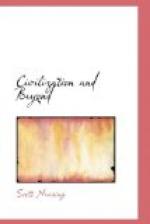Roman civilization under the Caesars was a centralized absolutism with a large measure of peripheral deviation and autonomy. It was directed by a central oligarchy and patrolled, defended and extended by a military force unified in theory but in practice grouped around the outstanding personalities and subjected to the vagaries and upsets always associated with power politics in the hands of military backed political despots.
Roman civilization, like all social organisms, came into being, moved toward maturity, reached a plateau of fulfillment from which it declined, broke up and eventually disappeared into the interregnum known as the Dark Ages. The entire episode occupied a dozen centuries. Its beginnings were unimpressively local. At the height of its wealth, power and cultural influence it bestrode the Eurasian-African triangle. Its decline and disappearance were no less spectacular than its meteoric rise to fame and fortune.
I would like to summarize the Roman experiment and some of its lessons by listing and commenting briefly on the forces that built up Roman civilization and those forces which resulted in its decline and dissolution.
Primary up-building forces in the Roman experiment:
1. Establishing the city of Rome as a stable, defensible center of merchandising and commerce, transport, finance, population, wealth and power with a hinterland of associates and dependencies. As it turns out, the city of Rome has outlived both the Roman Empire and Roman Civilization.
2. Steadfast dedication to
Roman interests first, by all necessary
means and despite costs which at
the time seemed to
be excessive.
3. A recognition of that which
is possible, especially in political
relationships. The acceptance
with good grace of a
half-loaf where no more was available.
4. Consistent, persistent aggression and expansion where such policies were beneficial to Rome, with little or no regard for their effects on Roman associates, allies, friends or enemies. Studied ruthlessness.
5. Rewarding Rome’s friends, allies and associates with economic, political and cultural advantages. Implacably punishing and where necessary exterminating Rome’s persistent enemies.
6. Wide tolerance of local
cultural variation in matters that
did not conflict with the major
principles and practices of
Rome’s central authority.
7. Taking defeats in their
stride, paying the price, and recovering
lost momentum. Again advancing
along avenues
which led to Roman success and aggrandizement.
8. Indomitable persistence in the pursuit of major objectives.
9. After the reigns of Julius Caesar and Augustus, concentrating power in a single person and his chosen brain trust, using that power to further aggrandize the Roman Empire and Roman Civilization.
This category is not complete. It aims to answer the basic question: In a situation where a thousand contestants entered the knock-down and drag-out struggle, first for survival and then for supremacy, what qualities or qualifications enabled Romans to win the laurel crown of victory?




